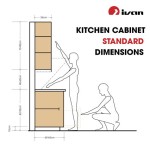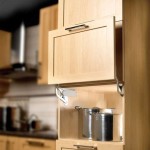What is the Average Size Kitchen Trash Can?
Determining the average size of a kitchen trash can requires an examination of various factors, including household size, waste generation habits, available space, and personal preferences. The market offers a wide array of trash can sizes, designed to accommodate different needs and kitchen layouts. While a single "average" size might not perfectly represent all households, understanding the common dimensions and capacities can provide a useful starting point for selecting the appropriate trash can for a given kitchen.
Kitchen trash cans are typically measured in gallons or liters, quantifying their capacity to hold waste. The dimensions, specifically height, width, and depth, are also critical considerations, as they dictate the physical footprint of the trash can within the kitchen. This article aims to explore the diverse range of kitchen trash can sizes, identify common dimensions, and provide guidance to help individuals make informed decisions when choosing a trash can that effectively meets their specific waste disposal requirements.
Common Kitchen Trash Can Capacities
Kitchen trash cans are available in a spectrum of sizes, each catering to different levels of waste production. Smaller households, such as single individuals or couples, may find smaller capacity trash cans sufficient. Conversely, larger families with more members and higher waste generation rates will invariably require larger-capacity options. Understanding the typical capacity ranges can significantly narrow down the selection process.
A capacity range of 10-13 gallons (approximately 38-49 liters) is often considered a standard size suitable for many average-sized kitchens and households. These trash cans are large enough to accommodate several days' worth of waste without requiring excessively frequent emptying, yet they remain manageable in terms of size and weight when full. This size range offers a balance between capacity and practicality for general kitchen use.
Smaller trash cans, in the 4-7 gallon (approximately 15-26 liters) range, are more commonly used in smaller kitchens, apartments, or as supplemental trash cans for specific purposes, such as recycling or composting. These compact options are ideal for individuals who generate minimal waste or those who prefer to empty their trash cans frequently to minimize odors.
Larger trash cans, exceeding 13 gallons (approximately 49 liters), are designed to accommodate the high waste volumes generated by large families or households that produce significant amounts of food waste, packaging materials, or other disposable items. These larger cans may also be suitable for commercial kitchens or spaces with high foot traffic and frequent waste disposal needs. While offering ample capacity, these larger trash cans occupy a significant amount of floor space and may be more difficult to handle when full.
The selection of an appropriate capacity should consider not only the volume of waste generated but also the frequency of trash collection services. If trash is collected only once a week, a larger capacity trash can may be necessary to avoid overflowing. Conversely, if trash is collected multiple times per week, a smaller capacity trash can may suffice. The aim should be to choose a size that minimizes the number of times the trash can needs to be emptied while preventing the accumulation of excessive waste that can lead to unpleasant odors or unsanitary conditions.
Typical Dimensions of Kitchen Trash Cans
Beyond capacity, the physical dimensions of a kitchen trash can are critical considerations, particularly in kitchens with limited space. The height, width, and depth of the trash can directly impact its placement and integration into the kitchen layout. Measuring the available space before purchasing a trash can is essential to ensure a proper fit and avoid obstructing walkways or interfering with other kitchen appliances or furniture.
A trash can with a capacity of 13 gallons will typically have dimensions in the range of 25-30 inches in height, 15-20 inches in width, and 12-18 inches in depth. These dimensions are approximate and can vary depending on the specific design and manufacturer. For example, a rectangular trash can may have a narrower width and a greater depth compared to a cylindrical trash can with the same capacity.
Smaller trash cans in the 4-7 gallon range will naturally have smaller dimensions, typically measuring between 15-20 inches in height, 10-15 inches in width, and 8-12 inches in depth. These compact dimensions make them suitable for tucking away under sinks, inside cabinets, or in narrow spaces.
Larger trash cans exceeding 13 gallons will correspondingly have larger dimensions, often reaching heights of 30 inches or more, with widths and depths exceeding 20 inches. These bulkier options may require dedicated floor space and careful consideration of their placement to avoid obstructing traffic flow in the kitchen.
When considering dimensions, it is also important to account for any additional features, such as a foot pedal, lid, or handles. These features can increase the overall dimensions of the trash can and should be factored into the space planning. For example, a trash can with a foot pedal may require additional clearance in front to allow for comfortable operation.
Factors Influencing Trash Can Size Selection
Numerous factors influence the optimal size of a kitchen trash can for a given household. Understanding these factors can help individuals make informed decisions and select a trash can that effectively meets their specific needs and preferences. Household size is a primary determinant, as larger families naturally generate more waste than smaller households.
Waste generation habits play a significant role. Households that produce a large amount of food waste, packaging materials, or recyclable items will require a larger capacity trash can. Conversely, households that actively reduce waste through composting, recycling, and mindful consumption can often manage with a smaller trash can.
Available space is a crucial consideration. Kitchens with limited floor space may necessitate a smaller trash can, even if the household generates a significant amount of waste. In such cases, frequent emptying may be required to compensate for the smaller capacity. Alternatively, wall-mounted or under-sink trash can options can help maximize space utilization in compact kitchens.
Desired features, such as a foot pedal, automatic lid, or odor control system, can also influence the size selection. These features may require additional space or dictate the overall dimensions of the trash can. Aesthetics and personal preferences also play a role. Some individuals may prefer a larger trash can to minimize the frequency of emptying, while others may prioritize a smaller, more discreet option that seamlessly integrates into the kitchen decor.
Furthermore, the frequency of trash collection services should be considered. If trash is collected only once a week, a larger capacity trash can is generally recommended to avoid overflowing. If trash is collected multiple times per week, a smaller capacity trash can may suffice. Understanding the local trash collection schedule is essential for selecting an appropriate size.
Finally, considering the type of waste generated is crucial. If the household produces a significant amount of wet waste, a trash can with a tight-fitting lid and odor control features is recommended. If the household primarily generates dry waste, a more basic trash can may suffice. Separating recyclable materials and compostable items from general trash can also reduce the overall volume of waste requiring disposal and potentially allow for a smaller trash can size.

What Size Trash Can Is Right For Your Home Kitchen Cans Unlimited

What Size Trash Can Is Right For Your Home Kitchen Cans Unlimited

Sterilite 1069 11 9 Gal Stepon Wastebasket White 10698004

Sterilite 1089 13 Gal Swing Top Wastebasket Black 10899004

Sterilite 1043 7 5 Gal Touchtop Wastebasket White 10438004

What Size Trash Can For Kitchen Is Best Plastic Place

Garbage Bags Sizes

Toter 48 Gallon Black Rolling Outdoor Garbage Trash Can With Wheels And Attached Lid 79248 R2200 The Home Depot

Sterilite 13 Gallon Trash Can Plastic Swing Top Kitchen White Com

Behrens 31 Gal Galvanized Steel Round Metal Household Trash Can With Lid 1270 The Home Depot
Related Posts








